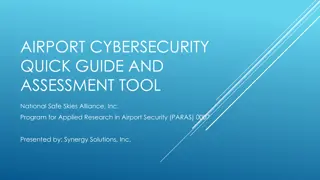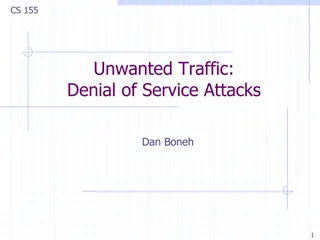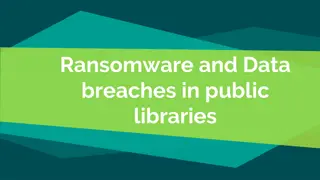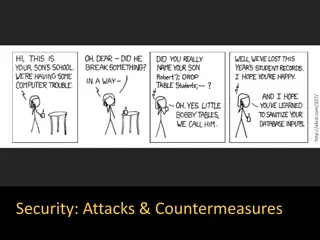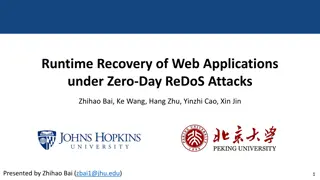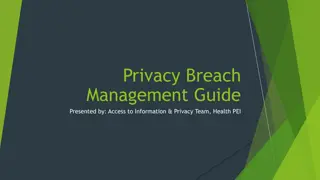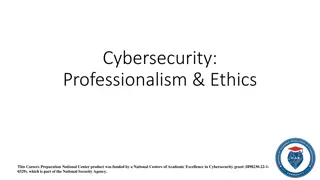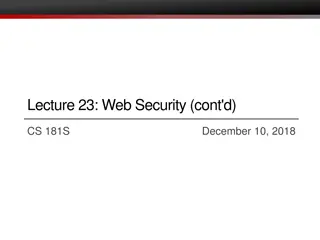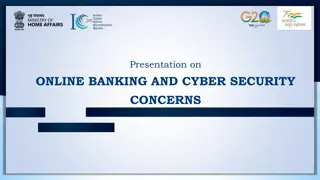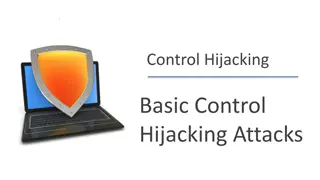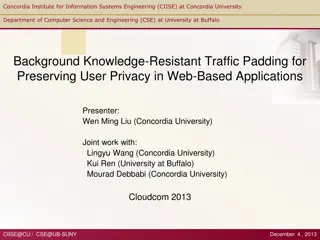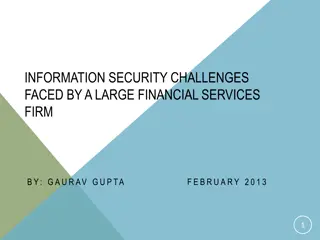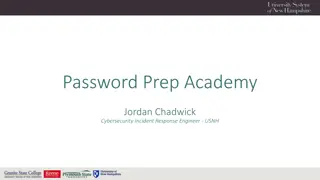Cybersecurity Challenges: Attacks on Web Applications and Cost of Security Breaches
In the realm of cybersecurity, attacks on web applications pose a significant threat with 78% of attacks targeting applications. The consequences of these attacks are immense, with projected costs reaching $6 trillion annually by 2021. Notable breaches in recent years highlight the urgency for robust security measures. Organizations face escalating costs, particularly from ransomware damages, emphasizing the need for proactive security strategies and adherence to OWASP security checklist for vulnerability mitigation.
Download Presentation

Please find below an Image/Link to download the presentation.
The content on the website is provided AS IS for your information and personal use only. It may not be sold, licensed, or shared on other websites without obtaining consent from the author. Download presentation by click this link. If you encounter any issues during the download, it is possible that the publisher has removed the file from their server.
E N D
Presentation Transcript
Lamidi Ismaila Senior Software Engineer Friday 29th November 2019
CYBERSECURITY: ATTACKS ON WEB APPLICATIONS
The Challenges Questions? Method of Web Attacks & Preventions Cost of these Attacks
Questions? The Challenges Method of Web Attacks & Preventions Cost of these Attacks
The Challenges A common statistic often shared by InfoSec professionals is that 78% of attacks are against the application . Not a week goes by without hearing of yet another massive breach or vulnerability, affecting millions of users across all industries. Last year 2018 witnesses some of the largest cyberattacks ever seen: hacks on the Marriott Group, Equifax, Yahoo, and Facebook all resulted in major data breaches. Add to this the increased level interference in election processes around the world, and it is clear that we are facing a crisis. Nigerian websites too are not left out as attacks against some Government own websites and even airline companies were at some points hijacked.
The Challenges Questions? Cost of these Attacks Method of Web Attacks & Preventions
Cost of these Attacks 1. consequences of hacks for businesses. They have found that cybercrime damages are expected to cost businesses $6 trillion annually by 2021, a number which they point out represents the biggest transfer of wealth in human history . The Cybersecurity Ventures Annual Crime Report for 2019 puts some numbers on the 2. the cost of ransomware will reach $20 billion by 2021. Of this $6 trillion, ransomware damages are the fastest growing. Cybersecurity Ventures say that 3. estimated to be $13 million a year. According to Accenture s global study, the average cost of cybercrime for organizations is
The Challenges Questions? Method of Web Attacks & Preventions Cost of these Attacks
Method of Web Attacks & Preventions The Open Web Application Security Project (OWASP), a worldwide not-for-profit charitable organization focused on improving the security of the software has created a security checklist which is often the first set of Vulnerabilities an attacker will attempt. The followings are OWASP security checklist
Method of Web Attacks & Preventions i) SQL Injection The SQL injection is a code injection technique, used to attack data-driven applications, in which malicious SQL statements are inserted into an entry field for execution (e.g. to dump the database contents to the attacker). SQL injection must exploit a security vulnerability in an application's software, for example, when user input is either incorrectly filtered for string literal escape characters embedded in SQL statements or user input is not strongly typed and unexpectedly executed. SQL injection is mostly known as an attack vector for websites but can be used to attack any type of SQL database. SQL injection attacks allow attackers to spoof identity, tamper with existing data, cause repudiation issues such as voiding transactions or changing balances, allow the complete disclosure of all data on the system, destroy the data or make it otherwise unavailable, and become administrators of the database server.
Method of Web Attacks & Preventions PREVENTION These attacks can be prevented by following a few principles: Validate all input regardless of the source Use a proper ORM (Object Relational Mapping) library depending on the application platform e.g for PHP there are Eloquent, Doctrine, Propel e.t.c Limit the potential damage of a successful exploit by reducing the application s database privileges
Method of Web Attacks & Preventions ii) Broken Authentication Most applications require their users to login before using it, often with a username/password combination. There are many types of common flaws with this authentication system, which can be exploited in a variety of ways: dictionary attacks, automated brute force, session hijacking, and more.
Method of Web Attacks & Preventions PREVENTION Preventing this requires a multi-layer approach: Change all default passwords. Enforce strong, random passwords for all users: at least 12 random characters, with no constraints, preferably stored in a password manager; or alternatively, a passphrase with at least 5 random words. Limit login attempts, locking the user account for a period of time after a certain number of wrong passwords. Use a secure platform session manager, which randomly generates long session identifiers and implements a secure session lifecycle. Protect passwords with a cryptographic passwordhash algorithm, such as Bcrypt, Scrypt. Implement a multi-factor authentication method.
Method of Web Attacks & Preventions iii) Broken Access Control Most web applications limit what users can see or do, whether it is accessing another user s personal data or a restricted area. However, the access control mechanisms that enforce these limits are usually bespoke implementations and often deeply flawed. Attackers can bypass these controls or abuse them to access unauthorized functionality or data, such as access other users accounts, view sensitive files, modify other users data, perform administrative actions, and more.
Method of Web Attacks & Preventions PREVENTION An in-depth review of all the application s features, system requirements, user roles, and other constraints is necessary. There are various common models that can be applied, depending on the requirements. The most common ones include Role-Based Access Control (RBAC), Discretionary Access Control (DAC), and Integrity based or Mandatory Access Control (MAC).
Method of Web Attacks & Preventions iv) Cross-Site Scripting (XSS) Cross-site scripting (XSS) is a type of computer security vulnerability typically found in web applications. XSS enables attackers to inject client-side scripts into web pages viewed by other users. A cross-site scripting vulnerability may be used by attackers to bypass access controls such as the same-origin policy. Cross-site scripting carried out on websites accounted for roughly 84% of all security vulnerabilities documented by Symantec up until 2017.
Method of Web Attacks & Preventions PREVENTION The chief protection against XSS attacks is the use of proper encoding. For example, HTML encoding will turn all special characters into HTML entities, such that they are displayed the same to the user but are not recognized by the parser as valid HTML tags. implement Content Security Policy (CSP), to prevent the browser from rendering an XSS attack that got through
Method of Web Attacks & Preventions v) DDoS Attack A Distributed Denial of Service (DDoS) attack is a non-intrusive internet attack made to take down the targeted website or slow it down by flooding the network, server or application with fake traffic. The Aim of DDoS Attack is when multiple systems overflow the bandwidth or resources of a targeted system, usually one or more web servers. DDOS Attack is often the result of multiple compromised systems (for example, a botnet) deluging the targeted system with traffic.
Method of Web Attacks & Preventions PREVENTION Activate a Web Application Firewall (WAF) which is a layer of protection that sits between a website and the traffic it receives. WAFs are a relatively new kind of firewall. They don t just block or allow traffic based on IP addresses and ports. They go a step further to analyze traffic and make decisions based on a set of predefined business rules. As their name implies, their main purpose is to secure web-based applications. There Cloud-Based WAFs and there are appliances that can be set up locally. Examples of cloud- based WAF includes https://www.cloudflare.com/, https://sucuri.net/website-security- platform/signup/ e.t.c
The Challenges Questions? Method of Web Attacks & Preventions Cost of these Attacks



